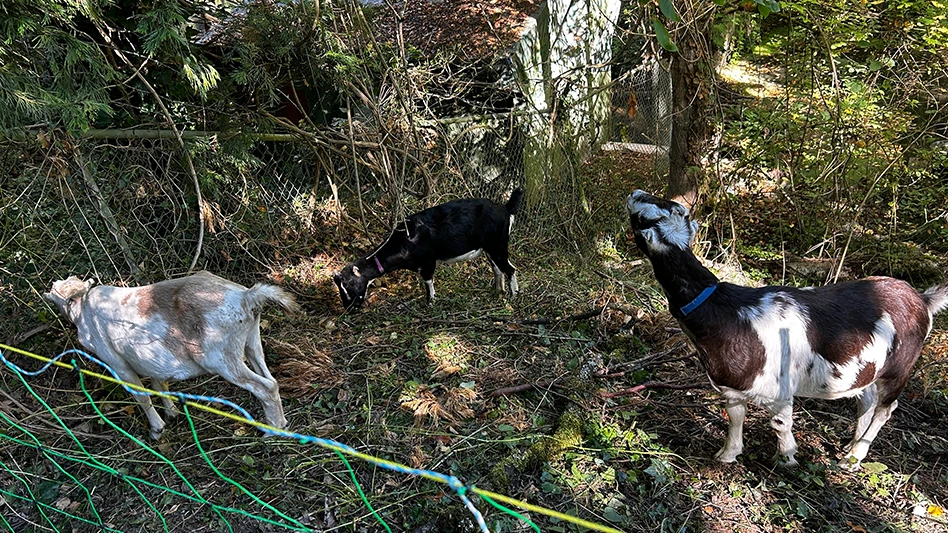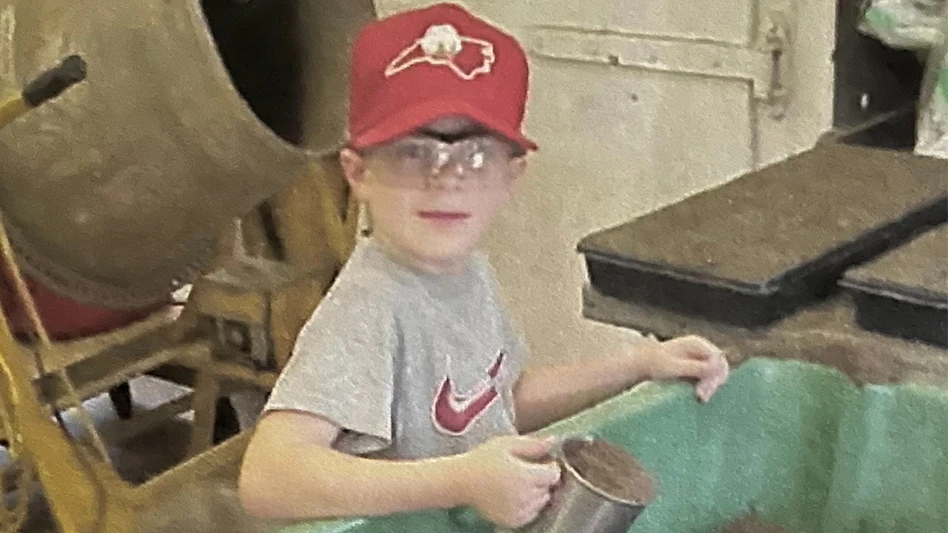

John Gosselin prepared for a job interview in the mid-1990s by visiting a Delaware library. Two decades later, his current employer is using a photograph from the collection he studied as a resource for a significant and swift restoration.
Gosselin, the superintendent at Aronimink Golf Club in Newtown Square, Pa., and his team are working with Philadelphia-based architect Gil Hanse and Total Turf Golf Services to return features of Donald Ross’s original design, including more than 170 bunkers. A black-and-white aerial photograph preserved in the Hagley Museum and Library’s Dallin Aerial Survey Company collection has aided the restoration.
Located 25 miles from Aronimink in Wilmington, Del., the Hagley Museum and Library once represented a haven for superintendents, architects and builders looking to study past imagery of Philadelphia, southern New Jersey and northern Delaware courses. The Dallin collection features more than 7,800 aerials, ranging from Mid-Atlantic cityscapes to amusement parks, captured from 1924 to 1939. The number of golf course images exceeds 500. Digitizing the collection has increased access to the images, which include photographs of Aronimink, Pine Valley, Merion and other Philadelphia-area gems.
Visiting the museum and library in the digital age evokes memories of completing a college research project. The grounds traverse a former industrial site along a soothing stretch of Brandywine Creek. When arriving at the library, a visitor must register, provide details about the collection they wish to scour, wear white gloves when sifting through boxes of glossy prints and scribble notes in pencil. Surprisingly, cell phone photos of the aerials are permitted. A golf course history and architecture savant will relish a visit – even if it feels somewhat inconvenient in 2017.
A digital option didn’t exist when Gosselin started using the Dallin collection for work purposes. He prepared for his job interview at Rolling Green Golf Club, where he worked from 1996-2000, by studying negatives from Dallin’s images of the William Flynn-designed course. Gosselin, who was working at nearby DuPont Country Club at the time, brought printed copies of the negatives to the interview. Rolling Green officials mentioned they had used three architects in five years as part of its renovation efforts. They were stunned to learn Gosselin possessed copies of aerials from the 1920s and 1930s depicting the course in the form Flynn intended.

Gosselin noticed aerials of other clubs, including Aronimink, during his visits to the library. As Aronimink begins a second fall and winter of construction, a poster-sized framed aerial of the course in 1929 sits in the maintenance facility conference room. The club used the aerial, along ground-level imagery and Ross sketches, to guide the restoration. Ross’s team completed the course in 1928.
Studying the materials illustrated major differences between the 1929 and 2015 versions of the golf course. Greens, for example, were much larger in 1929, and last fall and winter’s work resulted in the surfaces expanding by 29,000 square feet, increasing shot options and potential pin placements. “It’s like having another four or five greens depending on how big your greens are,” Gosselin says.
Bunkers are biggest piece of the restoration. The pre-construction course had 75 bunkers with 96,000 square feet of sand. Returning to the Ross bunkering will yield 200,000 square feet of sand when construction concludes this winter.
“It’s really unique in Donald Ross’s portfolio because of the number of bunkers and the style,” Gosselin says. “It was pretty much the height of his career in 1928. It wasn’t early in his career when he was just getting started. It wasn’t late. It was kind of in the middle of his career. I was hoping they would go back to what we are doing now.”
The number of bunkers and square footage of sand are jarring. But because of improved infrastructure, Gosselin says his crew spent about around the same time maintaining bunkers this past season as it did before the restoration. Constructing the bunkers – and giving them a Golden Age look – required intricate techniques, and Hanse, Jim Wagner and Jaeger Kovich handled all the shaping.
The project entered November ahead of schedule after intense work last fall and winter. The changes should spark architectural discussions when the PGA Tour returns Sept. 3-9, 2018 for the BWM Championship, the third leg of the FedEx Cup Playoffs.

And what about the Poa?
Members at Sewickley Heights Golf Club are learning carefully constructed Poa annua greens can generate a season-long buzz.
The suburban Pittsburgh club reopened May 5 following an extensive greens renovation. The project, featured in the October 2016 edition of GCI (http://goo.gl/xtyEfq), involved installing the necessary infrastructure to support high-quality Poa annua greens.
We returned to Sewickley Heights last month to visit superintendent Randall Pinckney, first assistant Corey Cheza, architect Jim Cervone and greens chairman Ted Kotarsky, and to see how the rebuilt greens have handled their first season. Members granted the team at Sewickley Heights a rare opportunity to develop the best possible situation for growing and maintaining Poa annua greens. Construction started Aug. 22, 2016 when a crew from Aspen Corporation arrived on site. Optimism permeated as a dry fall and mild winter expedited the work, which involved coring, installing drainage and irrigation, and laying sod on two greens per week.
The club was aiming for a late-May unveiling, but the Western Pennsylvania winter never turned nasty, giving Pinckney’s team openings to fertilize and spray, thus increasing root sizes as spring approached. The course reopened earlier than expected with a ribbon-cutting ceremony featuring World Golf Hall of Famer and Sewickley resident Carol Semple Thompson.
“Members were really crawling out of their skin to get back on it,” Cervone says. “We knew early on that it was going to be sooner than what we originally told them, but I don’t think anyone realized how early. It was really just a home run all the way around. I can’t recall any major issues or anything along the way that might have given us pause to say, ‘Oh, boy, we could be in trouble here.’ It really went off without a hitch.”
Sewickley Heights is expected to exceed 25,000 rounds this year, a high total for a northern private course closed until May. “The members are seeing what they paid for right now and they are excited about it,” Pinckney says. “I think the future of any golf course that wants to have good Poa greens is to do this. It’s wonderful for a club to be able to shut down if you can get away with doing it. You can see the results.”

Tartan Talks No. 16
A Chicagoan, Cyclone and great podcast guest.

We contacted Windy City-based architect Michael Benkusky for a Tartan Talks episode – and Benkusky delivered a podcast packed with goodies. The conversation loops to many topics, including bunker reduction, working on a Cold War missile site, and offering three- and six-hole options for time-crunched golfers.
An Iowa native, Benkusky learned the game playing and maintaining Donald Ross-designed Cedar Rapids (Iowa) Country Club. We didn’t ask Benkusky about his alma mater’s football resurgence – Benkusky majored in landscape architecture at Iowa State, where he was a member of the golf team – but we did slip in a question about a World Series celebration that has yet to end. Enter http://goo.gl/x5PYry into your web browser to hear the podcast.

Explore the November 2017 Issue
Check out more from this issue and find your next story to read.
Latest from Golf Course Industry
- The Aquatrols Company story
- Albaugh receives registration for chlorantraniliprole
- Honored by the association he helped expand
- The Carolinas GCSA Conference and Show: 5 W’s preview
- A great game. A sustainable game
- Envu welcomes new campaign activation manager
- Beyond the Page 61: An apprenticeship roundtable
- Epoch Science introduces Plant Fitness turf product line





